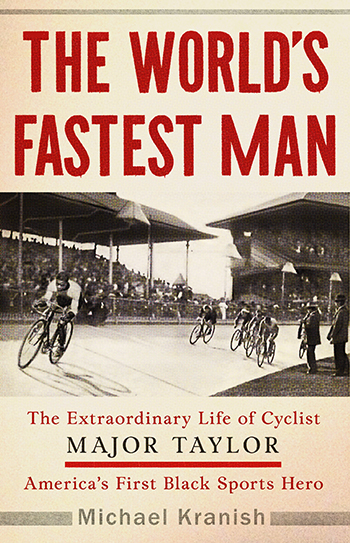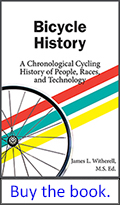

Major Taylor: The World's Fastest Man
Book review by Peter Joffre Nye
Chairman Bill's note: Author Peter Joffre Nye's latest work is his biography of Albert Champion, The Fast Times of Albert Champion: From Record-Setting Racer to Dashing Tycoon, An Untold Story of Speed, Success, and Betrayal (Prometheus Books). It is available in hardcover and Kindle eBook.
Champion (1878-1927) was an incredible man, as a bicycle racer he was winner of Paris-Roubaix and set more than a hundred world records. He went on to found both the Champion Spark Plug Company and General Motors Division AC Delco Systems.
Just click on the Amazon link to the right to get your copy of this terrific book.
Also on this site is Mr. Nye's story of one of cycling's toughest-ever racers, Reggie McNamara. McNamara won over 700 races and was one of the greatest-ever six-day racers. Oh, and there's more! Nye's story of Joseph Magnani, the Illinois rider who challenged Coppi and Bartali.
Enjoy!
THE WORLD’S FASTEST MAN: The Extraordinary Life of Cyclist Major Taylor, America’s First Black Sports Hero
By Michael Kranish. 384 pp. Illustrated. Scribner.

Major Taylor remains widely recognized today for breaking the color barrier in professional sports. In 1899 at the world cycling championships in Montreal, he won the professional sprint championship—and its attendant title of the world’s fastest man.
He also claimed a few U.S. national championships and set marquee world records, including the prized mile. After 1900 Taylor competed two seasons in Australia, when it took nearly a month to travel there by steamship from San Francisco, and toured Europe to race against national champs on their home tracks before he retired in 1910 as one of America’s first international superstar sports icons.
Major Taylor in an undated photo. From the Major Taylor Collection of the Indiana State Museum
Taylor already has been the subject of biographies—notably Andrew Ritchie’s Major Taylor, Todd Balf’s Major, and Conrad Kerber and Terry Kerber’s Major Taylor. American expat Jim Fitzpatrick wrote a book devoted to Taylor’s racing in Australia, Major Taylor in Australia, the subject of a movie feature, Tracks of Glory.
Taylor’s storied sixteen-year cycling career and his later life deserve retelling. He stands out as a pioneer African-American sports personality—decades before running sensation Jesse Owens hauled home gold medals from the 1936 Berlin Olympics and nearly a half-century before Jackie Robinson integrated Major League Baseball.
Taylor rose to fame in the late 1890s and earned a fortune racing on cycling tracks when they rivaled baseball and horse racing as America’s most popular spectator sport. He honed speed and handling skills against rivals setting world records, which boosted crowd sizes and box office gold for promoters. The United States achieved worldwide renown for fast racing. Several Americans won world cycling championships. These yeasty conditions proved bittersweet for Taylor. As a black man in a white man’s sport, he frequently bore the brunt of rampant Jim Crow laws enforcing segregation in restaurants and hotels not just in the South but also from New York to San Francisco.
Taylor and another rider with their bikes. From the Major Taylor Collection of the Indiana State Museum

Jim Witherell's book Bicycle History: A Chronological Cycling History of People, Races and Technology is available both in print and as a Kindle eBook. Just click on the Amazon link on the right to get your copy.
Peter Nye continues:
Kranish, an investigative reporter for the Washington Post, has published New York Times best-selling biographies, including the recent Trump Revealed. Kranish judiciously sets the context of Taylor’s life and times, bringing in educator and author Booker T. Washington, civil rights activist W.E.B. Du Bois, and financier J.P. Morgan. Kranish reminds readers about the significance of the landmark 1896 U.S. Supreme Court ruling Plessy versus Ferguson, which upheld the constitutionality of racial segregation as the law of the land.
Taylor had chain lightning in his legs. They gave him a sharp jump that propelled him to win track races. But his skin color made him vulnerable to mistreatment in America as the legal system was founded on the principal that African Americans were worth five-eighths of white citizens. White supremacy ruled.
In many ways Taylor’s rise bears familiar hallmarks. Born in Indianapolis in 1878, the fourth of eight children, the son of a laborer father and domestic servant mother, he transcended his humble background and soared to international fame through his sport.
Kranish has studiously scoured a wide range of periodicals, read Taylor’s autobiography, The Fastest Bicycle Rider in the World, pored over scrapbooks that Taylor kept, and interviewed Taylor’s daughter, Sidney Taylor Brown. Kranish’s eye for details brings life to old races in which Taylor competed on three continents.
Kranish has dug up some gems. One deals with young Jack Johnson of Galveston, Texas. Inspired to follow Taylor’s example of winning a world championship, Johnson took up bike racing. He improved rapidly and won races until he toppled over at speed around a turn. Injuries to his ribs and leg required hospitalization. Johnson decided to try a less dangerous profession and turned to boxing. In 1908 in Sydney, Australia, Johnson won the world heavyweight boxing championship.
Taylor’s best racing years were spent in abroad, especially in Paris, like three-time Tour de France winner Greg LeMond. Taylor has been honored with a statue erected outside the Worcester library in his adopted home-town of Worcester, Massachusetts. A concrete velodrome in his native Indianapolis bears his name, the Major Taylor Velodrome, the site of many national championships. In 1989 Taylor was represented by his daughter Sydney Taylor Brown at his induction into the U.S. Bicycling Hall of Fame.
Taylor was a complex man living in a racially-charged time, which in many ways still lingers in our regular news cycles. Michael Kranish has written a thoroughly researched biography, a compelling social-history, a wonderful page turner.
Peter Joffre Nye’s updated and revised HEARTS OF LIONS: THE EPIC SAGA OF AMERICAN TRACK AND ROAD BICYCLE RACING, was published in 2020 by the University of Nebraska Press.







